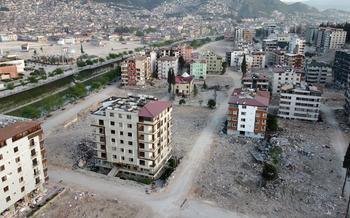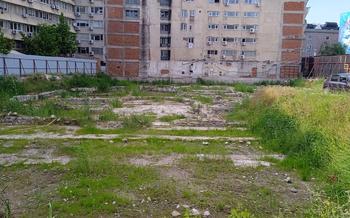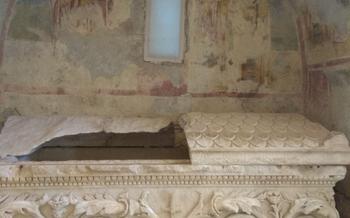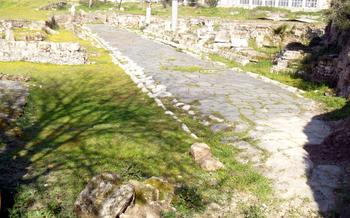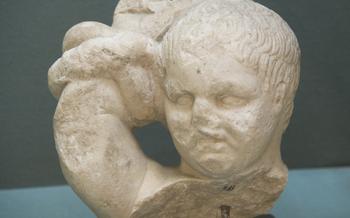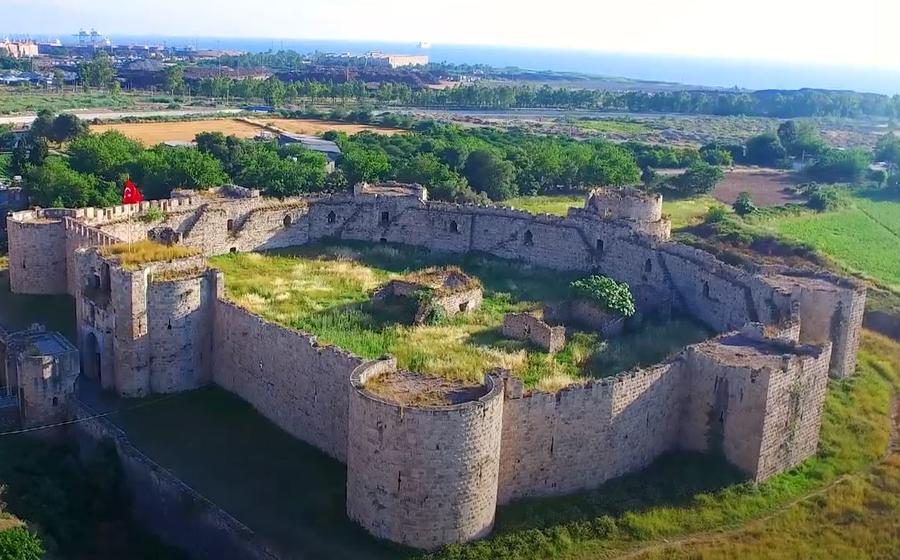
Hatay Ethnography Museum
- Hatay Ethnography Museum: Unveiling the Cultural Tapestry of Hatay
- Exploring the Museum's Diverse Exhibits
- Hatay's Rich Cultural Heritage: A Melting Pot of Civilizations
- Traditional Crafts and Handicrafts: A Journey into Local Artisanship
- Culinary Delights: A Taste of Hatay's Flavors
- 1 A Journey Through Regional Cuisine
- 2 Influences and Fusion
- 3 Interactive Cooking Experiences
- Folk Music and Dance: Expressions of Cultural Identity
- Religious Diversity: A Tapestry of Faiths
- Hatay's Natural Wonders: A Symphony of Landscapes
- Storytelling Through Artifacts: A Glimpse into Local History
- Educational Programs and Workshops: Engaging with Local Culture
- Temporary Exhibitions: A Window to Contemporary Expressions
- Accessibility and Visitor Facilities: Creating an Inclusive Experience
- Volunteering and Community Involvement: Contributing to Cultural Preservation
- Research and Scholarship: Advancing Knowledge and Understanding
- Insider Tip: Unveiling Hidden Gems and Capturing the Essence of Hatay
Hatay Ethnography Museum: Unveiling the Cultural Tapestry of Hatay
Historical Background and Significance:
Nestled in the heart of Hatay, Turkey, the Hatay Ethnography Museum stands as a testament to the region's rich cultural heritage. Founded in 1974, the museum plays a pivotal role in preserving and showcasing the diverse traditions, customs, and artifacts that have shaped Hatay's unique identity. Its establishment marked a significant milestone in the region's efforts to celebrate and protect its cultural legacy.
Architectural Features and Design:
The museum's architectural design seamlessly blends traditional and modern elements, creating a visually striking edifice that complements the surrounding cityscape. The building's exterior features intricate stonework and arched windows, reminiscent of the region's historical architecture. Inside, visitors are greeted by spacious galleries and well-curated exhibits, each designed to provide an immersive and educational experience.
Importance of the Museum in Preserving Hatay's Cultural Heritage:
The Hatay Ethnography Museum serves as a repository for the region's tangible and intangible cultural heritage. Through its extensive collection of artifacts, the museum aims to preserve and promote the diverse traditions, customs, and practices that have been passed down through generations. The museum's dedication to showcasing Hatay's unique cultural identity has earned it recognition as a vital institution for safeguarding the region's rich past.
Exploring the Museum's Diverse Exhibits
The Hatay Ethnography Museum is a treasure trove of cultural artifacts and exhibits that showcase the diverse heritage of the region. Upon entering, visitors are greeted by a stunning display of traditional costumes, intricately embroidered with vibrant colors and delicate patterns. These costumes represent the rich textile traditions of Hatay, where each piece tells a story of craftsmanship and cultural identity.
Further exploration reveals an array of jewelry, ranging from delicate filigree earrings to elaborate necklaces adorned with gemstones. The intricate designs and meticulous craftsmanship of these pieces reflect the artistry and skill of local artisans. Visitors can also admire a collection of pottery, copperware, and other household items that provide a glimpse into the daily lives and customs of Hatay's people.
Interactive displays and educational resources enhance the museum experience, allowing visitors to delve deeper into the cultural significance of the exhibits. Audio guides offer detailed explanations of the various artifacts, while touchscreens and multimedia presentations provide additional information and insights. These interactive elements make the museum a vibrant and engaging space for visitors of all ages.
Hatay's Rich Cultural Heritage: A Melting Pot of Civilizations
Hatay, a region nestled in the southeastern corner of Turkey, boasts a rich cultural heritage shaped by a diverse array of civilizations that have called this land their home. Throughout history, Hatay has served as a crossroads for trade, migration, and cultural exchange, resulting in a unique blend of traditions, languages, and religions.
The Hatay Ethnography Museum plays a crucial role in showcasing this cultural diversity. Its exhibits provide a glimpse into the region's past, showcasing the contributions of various ethnic groups, including the Hittites, Assyrians, Greeks, Romans, Byzantines, Arabs, and Ottomans. Through interactive displays and educational resources, visitors can explore the region's unique blend of cultures and gain a deeper understanding of its historical significance.
Preserving and celebrating Hatay's cultural heritage is essential for maintaining the region's distinct identity. The Hatay Ethnography Museum serves as a custodian of this rich legacy, ensuring that future generations can appreciate and learn from the diverse cultural influences that have shaped this fascinating region.
Traditional Crafts and Handicrafts: A Journey into Local Artisanship
Among the many treasures housed within the Hatay Ethnography Museum, the exhibits showcasing traditional crafts and handicrafts offer a fascinating glimpse into the region's rich artisanal heritage. These displays celebrate the skill and artistry of local craftsmen and women, who have passed down their techniques and knowledge through generations.
Visitors can marvel at intricate woven textiles, adorned with vibrant patterns and motifs that tell stories of Hatay's cultural identity. Embroidered fabrics, with their delicate needlework and colorful threads, showcase the patience and precision of local artisans. Pottery, with its diverse forms and glazes, reflects the region's mastery of ceramics.
The museum also hosts workshops and demonstrations that provide visitors with hands-on experiences in traditional crafts. These workshops offer a unique opportunity to learn from skilled artisans, try their hand at weaving, embroidery, or pottery, and gain a deeper appreciation for the artistry and craftsmanship that goes into each piece.
Through these exhibits and workshops, the Hatay Ethnography Museum not only preserves and showcases traditional crafts but also fosters a sense of pride and appreciation for the region's rich cultural heritage. Visitors leave the museum with a newfound respect for the skill and dedication of local artisans and a deeper understanding of the cultural significance of traditional crafts.
Culinary Delights: A Taste of Hatay's Flavors
1 A Journey Through Regional Cuisine
The Hatay Ethnography Museum offers a tantalizing journey through the region's culinary delights. Displays of traditional dishes, local ingredients, and cooking techniques provide a glimpse into the rich tapestry of Hatay's cuisine. Visitors can immerse themselves in the aromas and flavors that have made Hatay renowned as a gastronomic paradise.
2 Influences and Fusion
The region's strategic location at the crossroads of civilizations has resulted in a unique blend of culinary influences. From the vibrant flavors of the Middle East to the Mediterranean's fresh and zesty ingredients, Hatay's cuisine is a harmonious fusion of diverse culinary traditions.
3 Interactive Cooking Experiences
To enhance the visitor experience, the museum offers interactive cooking demonstrations and workshops. These hands-on sessions provide a deeper understanding of local recipes and techniques. Participants can learn to prepare traditional dishes, such as savory kebabs, fragrant stews, and delectable pastries, under the guidance of experienced chefs.
Folk Music and Dance: Expressions of Cultural Identity
The Hatay Ethnography Museum celebrates the rich tapestry of Hatay's cultural heritage through its exhibits on traditional folk music and dance. Immerse yourself in the vibrant sounds of the region, from the soulful melodies of the bağlama, a stringed instrument, to the rhythmic beats of the def, a frame drum. Admire the intricate costumes worn by dancers, adorned with colorful embroidery and intricate beadwork, reflecting the region's diverse ethnic influences.
Interactive displays bring these art forms to life, allowing visitors to experience the energy and passion of Hatay's folk performances. Watch videos of traditional dance troupes in action, or listen to recordings of local musicians playing beloved tunes. Participate in interactive quizzes to test your knowledge of Hatay's musical heritage or learn a few basic dance steps to join in the celebration.
Folk music and dance in Hatay are not merely forms of entertainment; they are expressions of cultural identity, community spirit, and the enduring traditions of the region. They serve as a reminder of the shared history and heritage that unite the people of Hatay and contribute to the region's unique cultural landscape.
Religious Diversity: A Tapestry of Faiths
Hatay's diverse religious traditions are a testament to its rich cultural heritage. The Hatay Ethnography Museum showcases the harmonious coexistence of Christianity, Islam, and Judaism in the region. Displays highlight the unique customs, rituals, and artifacts associated with each faith, providing visitors with an insight into the deep-rooted spiritual traditions that have shaped Hatay's identity.
The museum's exhibits emphasize the peaceful coexistence and mutual respect among different religious communities. Visitors can learn about the shared values and beliefs that unite the people of Hatay, despite their religious differences. This aspect of the museum's collection serves as a reminder of the importance of religious tolerance and understanding in promoting social harmony and unity.
Through interactive displays and educational resources, the museum encourages visitors to engage with the diverse religious traditions of Hatay. This fosters a deeper appreciation for the region's cultural heritage and promotes dialogue and understanding among people of different faiths.
Hatay's Natural Wonders: A Symphony of Landscapes
The Hatay Ethnography Museum not only delves into the cultural heritage of the region but also showcases the breathtaking natural beauty that Hatay possesses. Through interactive displays and exhibits, visitors can explore the diverse landscapes that make up this enchanting province. From the majestic mountains that embrace the region, to the lush forests that provide a sanctuary for its flora and fauna, and the mesmerizing coastline that stretches along the Mediterranean Sea, the museum offers a glimpse into Hatay's natural wonders.
The museum's exhibits highlight the importance of environmental conservation and sustainable tourism, encouraging visitors to appreciate and protect the region's natural heritage. Interactive displays allow visitors to explore Hatay's unique ecosystems, learn about the diverse plant and animal species that call it home, and understand the delicate balance that exists between human activities and the environment.
Whether it's the towering peaks of Mount Keldağ, the verdant expanse of the Amanos Mountains, or the pristine beaches of the Mediterranean coast, the Hatay Ethnography Museum invites visitors to discover the natural wonders that complement the region's rich cultural heritage.
Storytelling Through Artifacts: A Glimpse into Local History
Artifacts on display at the Hatay Ethnography Museum are not just objects; they are vessels of stories, each carrying a piece of the region's rich history. From a weathered farming tool that speaks of generations of agricultural heritage to an intricately embroidered headscarf that whispers tales of a skilled artisan's labor of love, every item holds a unique narrative.
One particularly poignant exhibit is a worn-out leather pouch, its surface etched with the passage of time. Accompanying it is a handwritten note, penned by its original owner, a shepherd from the nearby mountains. In his words, we learn of his nomadic life, the challenges he faced, and the solace he found in the companionship of his flock. Through this simple object, we gain a profound glimpse into the life of a man who lived and breathed the traditions of the land.
The museum encourages visitors to engage with these artifacts on a deeper level, to let their imaginations wander and piece together the stories they hold. Interactive displays invite visitors to handle replicas of historical tools, try on traditional clothing, and listen to recorded anecdotes from local elders. These experiences transform the museum into a living tapestry of Hatay's past, where visitors become active participants in the storytelling process.
By presenting artifacts as more than just objects, the Hatay Ethnography Museum invites visitors to connect with the human experiences that shaped the region's cultural heritage. These stories, woven together, create a rich tapestry that brings the past to life and fosters a deeper appreciation for the diverse traditions that make Hatay a truly istimewa, or special, place.
Educational Programs and Workshops: Engaging with Local Culture
The Hatay Ethnography Museum offers a range of educational programs and workshops designed to engage visitors with the region's rich cultural heritage. These programs provide an immersive and interactive experience, allowing participants to learn about traditional crafts, cooking, music, and dance firsthand.
Visitors can participate in weaving workshops to master the art of creating intricate patterns on traditional looms. Skilled artisans guide participants through the process, sharing their techniques and knowledge. Embroidery workshops offer the opportunity to learn various stitches and create beautiful designs on fabric.
Cooking enthusiasts can immerse themselves in the flavors of Hatay's cuisine through hands-on cooking workshops. Participants learn to prepare traditional dishes using fresh, local ingredients and discover the culinary influences that have shaped the region's unique flavors.
Music and dance enthusiasts can join workshops to learn about traditional musical instruments and dance movements. Experienced instructors lead participants through traditional melodies and rhythms, allowing them to gain a deeper understanding of Hatay's vibrant folk arts.
These educational programs not only provide a fun and engaging experience but also promote cultural exchange and foster a deeper appreciation for the diverse traditions of Hatay. Visitors leave the museum with a newfound understanding of the region's rich cultural heritage and a desire to learn more.
Temporary Exhibitions: A Window to Contemporary Expressions
The Hatay Ethnography Museum not only delves into the region's rich past but also provides a platform for contemporary artistic expressions through temporary exhibitions. These exhibitions showcase the works of local, national, and international artists, photographers, and cultural enthusiasts, offering a fresh perspective on Hatay's ever-evolving creative landscape.
Temporary exhibitions at the museum serve as a window to the current trends, ideas, and issues that shape Hatay's cultural identity. They explore diverse themes ranging from modern art and photography to contemporary interpretations of traditional crafts and cultural practices. These exhibitions foster dialogue, encourage critical thinking, and provide a space for visitors to engage with contemporary expressions of Hatay's vibrant cultural tapestry.
Through temporary exhibitions, the museum aims to promote local artists, support cultural exchange, and create a dynamic and inclusive platform for artistic expression. It encourages visitors to explore the intersections of tradition and modernity, challenge their perceptions, and gain a deeper understanding of the ever-changing cultural landscape of Hatay.
Accessibility and Visitor Facilities: Creating an Inclusive Experience
The Hatay Ethnography Museum prioritizes accessibility and inclusivity for visitors from all backgrounds. The museum features ramps, elevators, and audio guides to ensure that individuals with disabilities can comfortably navigate and explore the exhibits. Guided tours are available in multiple languages to cater to international visitors and those who prefer a more structured experience. The museum also provides amenities such as a gift shop, a café, and rest areas where visitors can relax and recharge during their visit. The friendly and knowledgeable staff is always ready to assist visitors with any questions or requests, creating a welcoming and supportive environment for all.
Volunteering and Community Involvement: Contributing to Cultural Preservation
The Hatay Ethnography Museum welcomes volunteers who are passionate about cultural preservation and eager to contribute to the museum's mission. Volunteering at the museum offers a unique opportunity to gain hands-on experience in various aspects of museum operations, while also making a valuable contribution to the local community.
Volunteers can assist with tasks such as leading guided tours, assisting with educational programs and workshops, conducting research projects, or providing administrative support. By volunteering their time and skills, individuals can play an active role in preserving and promoting Hatay's rich cultural heritage.
The museum also encourages community involvement through partnerships with local organizations, schools, and cultural groups. These collaborations help to foster a sense of ownership and responsibility for the museum among the local community. By working together, the museum and the community can ensure that Hatay's cultural heritage continues to thrive for generations to come.
Whether you are a history buff, a culture enthusiast, or simply someone who wants to give back to the community, volunteering at the Hatay Ethnography Museum is a rewarding and fulfilling experience. It is an opportunity to connect with like-minded individuals, learn new skills, and make a lasting impact on the preservation of Hatay's cultural treasures.
Research and Scholarship: Advancing Knowledge and Understanding
The Hatay Ethnography Museum is not merely a repository of cultural artifacts; it is also a hub for research and scholarship. The museum collaborates with academic institutions to conduct in-depth studies on Hatay's cultural heritage, exploring its diverse aspects and connections to broader historical and anthropological contexts.
Researchers have access to a wealth of resources at the museum, including a specialized library, archives, and online databases. These resources encompass historical documents, photographs, oral histories, and ethnographic accounts that shed light on the region's rich past. Scholars can delve into the museum's collection, conducting research on topics ranging from traditional crafts and customs to religious practices and social structures.
The museum's commitment to research extends beyond its walls. It organizes conferences, workshops, and seminars that bring together scholars, experts, and enthusiasts from various fields. These events facilitate the exchange of ideas, promote dialogue, and contribute to the advancement of knowledge about Hatay's cultural heritage.
By fostering research and scholarship, the Hatay Ethnography Museum plays a crucial role in preserving and understanding the region's cultural legacy. It ensures that Hatay's unique heritage is not only documented and preserved but also studied, interpreted, and shared with the wider world.
Insider Tip: Unveiling Hidden Gems and Capturing the Essence of Hatay
While exploring the Hatay Ethnography Museum, be sure to venture beyond the main exhibits to uncover hidden gems that offer a unique perspective on the region's cultural tapestry. One such treasure is the Traditional Hatay House, a meticulously recreated dwelling that transports visitors back in time. Step inside to experience the ambiance of a typical Hatay home, complete with intricately carved wooden furniture, colorful kilims, and traditional cooking utensils.
To fully immerse yourself in the museum's offerings, plan your visit for a weekday morning, when the crowds are thinner, allowing you to engage with the exhibits at a leisurely pace and soak in the tranquil atmosphere. This will provide ample opportunity to capture stunning photographs of the museum's architectural details, artifacts, and captivating displays without the distraction of large tour groups.
